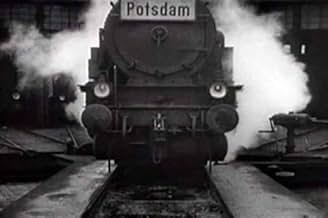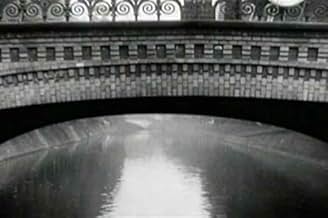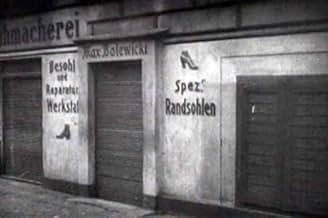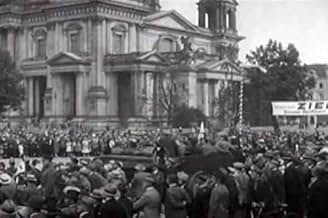Berlin, symphonie d'une grande ville
Titre original : Berlin - Die Sinfonie der Großstadt
NOTE IMDb
7,6/10
5 k
MA NOTE
Ce film nous montre une journée à Berlin, le rythme du temps qui passe, du petit matin aux plus profondes heures de la nuit.Ce film nous montre une journée à Berlin, le rythme du temps qui passe, du petit matin aux plus profondes heures de la nuit.Ce film nous montre une journée à Berlin, le rythme du temps qui passe, du petit matin aux plus profondes heures de la nuit.
- Réalisation
- Scénario
- Casting principal
Paul von Hindenburg
- Self
- (non crédité)
Avis à la une
Berlin: City Symphony is one of those early experiments in montage - early as in before sound was invented and right after Battleship Potemkin changed everything. It's not always montage, as some might believe from its recommendations (i.e. Koyannasquati), as the director Walter Ruttmann is making documentary as much as city-scape. It's about a full day and night among the dwellers and the objects of a city: the moving trains, the people shuffling by about their various concerns, and the people at jobs and things like a factory at work and phones being answered used for editing fodder.
Some of this is dazzling work, cut and speed up to reflect a mood of a city that is vibrant and hectic, imaginative and crazy, and sometimes tending for the dramatic. Ruttmann also has a rather weird design with the pacing at times; a woman in one 'scene' looks over a river, and in a state of sorrow falls over. People rush over to see what has happened, and we see a shot of the water and the woman gone under... and then it cuts right away to a beauty pageant! It throws a viewer off to see Ruttmann's unconventional choices, and how images flow together like the racers (cars, horses, people, boxcars), and there develops a simple but engrossing poetry of people as "actors" in front of a camera on their daily travels or having fun like at the funshow in the auditorium. It's not always as exciting or delirious as a Russian counterpart like Man with a Movie Camera or Kino Eye, but it pays loving tribute to its city at its time and place, showing the light with the dark, the commonplace with the unusual.
Some of this is dazzling work, cut and speed up to reflect a mood of a city that is vibrant and hectic, imaginative and crazy, and sometimes tending for the dramatic. Ruttmann also has a rather weird design with the pacing at times; a woman in one 'scene' looks over a river, and in a state of sorrow falls over. People rush over to see what has happened, and we see a shot of the water and the woman gone under... and then it cuts right away to a beauty pageant! It throws a viewer off to see Ruttmann's unconventional choices, and how images flow together like the racers (cars, horses, people, boxcars), and there develops a simple but engrossing poetry of people as "actors" in front of a camera on their daily travels or having fun like at the funshow in the auditorium. It's not always as exciting or delirious as a Russian counterpart like Man with a Movie Camera or Kino Eye, but it pays loving tribute to its city at its time and place, showing the light with the dark, the commonplace with the unusual.
It's like Koyaanisqatsi of 20s! It's miraculous! Awesome! It's all about the idea of a great city moving forward up-tempo but still having quite common problems of Germany's twenties poverty and exacerbation, nevertheless Berlin being one of the most fashionable cities of Europe of that particular time. But it's not the movie's main account. Its atmosphere was created by excellent cameraman work. The frame when a train moves right into you and then suddenly turns away is quite impressive. Never seen that advanced cameraman till Citizen Kane. I'd also definitely recommend watching Ruttmann's 'Lichtspiel Opus I ', an avant-garde animated movie created in 1921.
This is a silent era documentary showing a day in the life of Berlin starting from the morning to the late night. It shows people and places in their day to day existence. It's artistic like showing the machinery at work. It's fascinating to see people in their everyday lives. It's amazing to see the places especially since most of them were destroyed in WWII. It's great to see living lives in this time era. This is a world in between the two Great Wars. The economic crash has yet to happen. It's a Germany which still functions with its old wealth and new technology. It's a working city. It's a great time capsule and a terrific movie by itself.
An amazing work of the 'slice of life' films of the 20s, really the main and most admirable example along with Dziga vertov's Man With the Movie Camera, to this day, the film remains an effective portrayal of the great city that Berlin was even back when the film was made. In fact, as time goes by, it picks up even greater importance because of the historical value that it holds.
What is truly admirable is the editing and the cinematography. Perhaps even more than the things that are contained in the framework, is the framework itself which has the first impact on the viewer. The wonderful photography, and the skilled editing that is able to go from man to machine, from trains to horses, from workmen to roller-coaster rids, are always elegant and original, even in regards to Vertov's later work mentioned above. It is, in fact, stylistically a Ruttmann work. Although the work of Vertov and Ruttmann are similar, there is a difference in the sense that while The man With the Movie Camera is aware of being a film, and plays with the process of film-making, Berlin actually lets the contents of the framework play out, and never quite interferes with it.
What is truly admirable is the editing and the cinematography. Perhaps even more than the things that are contained in the framework, is the framework itself which has the first impact on the viewer. The wonderful photography, and the skilled editing that is able to go from man to machine, from trains to horses, from workmen to roller-coaster rids, are always elegant and original, even in regards to Vertov's later work mentioned above. It is, in fact, stylistically a Ruttmann work. Although the work of Vertov and Ruttmann are similar, there is a difference in the sense that while The man With the Movie Camera is aware of being a film, and plays with the process of film-making, Berlin actually lets the contents of the framework play out, and never quite interferes with it.
Place: Berlin. Span: one day in the life of the city circa 1927 captured by the camera. We enter by train.
One way to watch this, the most obvious I guess, is as a historic document, a snapshot of life as it was once. The old world just barely impregnated with faint traces of an archaic modernity; street cars, neon signs, busy streets, things we have now but were then just beginning to greet people. So with this mindset, as a museum piece that depicts an old version of our world.
This is fine, but I urge you to engage it differently if you can.
What if instead of merely observing exhibits from behind a glass panel, we get out from the museum into actual life? Instead of settling in for this as a historic - meaning dead, embalmed, academic - glimpse, we invigorate it with life that we know, with sunlight, texture, sound, breath that was then as real as it is now? How would it be in absolute stillness to feel present in the middle of a modern life?
This is how the film was intended after all, it's plainly revealed this way. Not a fossil for generations of curious tourists from the future, but a celebration of life 'now', modern, busy life out the window.
So no longer an old world that faintly reminds us of our own, but a new world, exciting, alluring, mysterious, alive with myriad possibilities. New things everywhere, novel pathways to travel, environments to experience. What I mean is, try to see the city as though you just got off the train and were visiting for the first time. It ends with the camera spinning around a flashing neon sign cut to match with fireworks erupting in the night sky.
I urge you to inhabit this, settle for nothing less. Let its neon flowers blossom in you.
One way to watch this, the most obvious I guess, is as a historic document, a snapshot of life as it was once. The old world just barely impregnated with faint traces of an archaic modernity; street cars, neon signs, busy streets, things we have now but were then just beginning to greet people. So with this mindset, as a museum piece that depicts an old version of our world.
This is fine, but I urge you to engage it differently if you can.
What if instead of merely observing exhibits from behind a glass panel, we get out from the museum into actual life? Instead of settling in for this as a historic - meaning dead, embalmed, academic - glimpse, we invigorate it with life that we know, with sunlight, texture, sound, breath that was then as real as it is now? How would it be in absolute stillness to feel present in the middle of a modern life?
This is how the film was intended after all, it's plainly revealed this way. Not a fossil for generations of curious tourists from the future, but a celebration of life 'now', modern, busy life out the window.
So no longer an old world that faintly reminds us of our own, but a new world, exciting, alluring, mysterious, alive with myriad possibilities. New things everywhere, novel pathways to travel, environments to experience. What I mean is, try to see the city as though you just got off the train and were visiting for the first time. It ends with the camera spinning around a flashing neon sign cut to match with fireworks erupting in the night sky.
I urge you to inhabit this, settle for nothing less. Let its neon flowers blossom in you.
Le saviez-vous
- AnecdotesThe shooting was done over 18 months though the resulting feature gives the impression of just one day in the city.
- ConnexionsFeatured in Lulu in Berlin (1984)
Meilleurs choix
Connectez-vous pour évaluer et suivre la liste de favoris afin de recevoir des recommandations personnalisées
- How long is Berlin: Symphony of Metropolis?Alimenté par Alexa
Détails
- Date de sortie
- Pays d’origine
- Langue
- Aussi connu sous le nom de
- Berlin: Symphony of a Metropolis
- Lieux de tournage
- Berlin Cathedral, Mitte, Berlin, Allemagne(aka Berliner Dom)
- Sociétés de production
- Voir plus de crédits d'entreprise sur IMDbPro
- Durée1 heure 5 minutes
- Couleur
- Mixage
- Rapport de forme
- 1.33 : 1
Contribuer à cette page
Suggérer une modification ou ajouter du contenu manquant




















